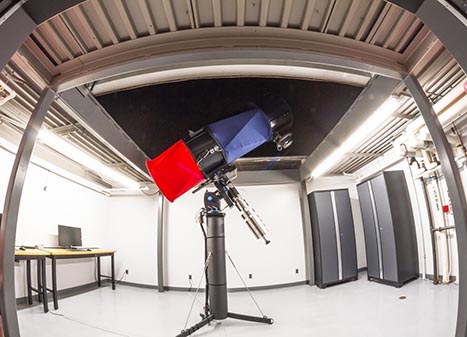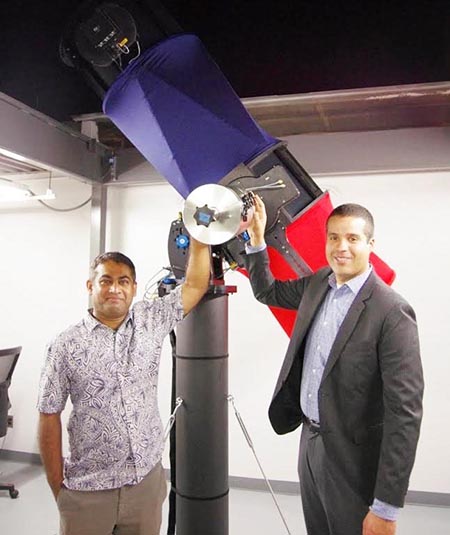Solving the orbital debris problem - one observation at a time
Trouble in orbit
Lost on your way to an important meeting? – turn on your navigation system. Trying to decide what to wear? – check the weather. What would you do if these simple solutions were no longer possible?
Behind every navigation system, or weather prediction is a satellite system or constellation of such systems continually working to provide these day-to-day services. From banking transactions to global communication to GPS mapping – we rely on satellite technology.
One threat faced by the satellite systems that provide these services is the rapidly increasing amount of space debris in near earth orbit. There are currently millions of these debris, otherwise known as “space junk,” orbiting earth, and their vast quantity and speed is a threat to anything crossing paths with them.
In low earth orbit, where most Space Junk resides, objects travel at 2-4 miles per second. At this speed, even an object as small as a paint fleck could render great damage to a satellite upon collision.
And if we don’t do anything to stop this, the situation will only continue to worsen.
With each collision, the probability of another occurring increases. This situation, known as the Kessler Syndrome, has the potential to leave much of space uninhabitable. It is vital that we develop a detailed understanding of the orbital debris population’s characteristics in order to prevent such a scenario, and to preserve the space habitat for generations to come.
Saving our satellites
Working in collaboration with the University of Arizona (UofA), AEM Professor, Richard Linares, his Postdoctoral research associate, Piyush Mehta, and a team of University of Minnesota (UMN) students have set out to solve this issue. By combining Professor Linares’s expertise in space debris characterization with the University of Arizona’s expertise in small telescope technologies, the groups have a unique capability for solving the orbital debris problem; an optical telescope with the ability to track space debris and satellites.

“Solving the orbital debris problem requires developing a more detailed understanding of the orbital debris population,” says Professor Linares. “The goal of our telescope network is to conduct research on improving the knowledge of the orbital debris population.”
The telescope, which was constructed from the ground up by a group of five students at the University of Arizona will be equipped with two software programs designed by University of Minnesota undergraduate students, Michael Schmidt and Garrett Peloquin.
“Over the summer, I have been working to develop software to determine which objects are visible in the night sky, create ranking criteria to most effectively rank the objects for viewing, and to essentially output an optimized list of which objects should be viewed at any given time,” says Michael, who got involved in the project Spring semester when he had Professor Linares for the course, Orbital Mechanics.
“Near the end of the semester, Professor Linares mentioned that he was collaborating with the University of Arizona to build a telescope capable of autonomously tracking objects in orbit, and said he was looking for someone to work on creating the software,” continues Michael. “I’ve always found space to be intriguing, as it’s an area of research where there is still a lot of unknowns left to be determined, and I was grateful to work on this project and to be able to contribute to scientific research.”
Meanwhile Michael’s colleague, Garrett has been working on the data visualization and presentation for the project. “I take the information the telescope outputs and the goal is to turn it into an animation or gif that is easy to understand,” says Garrett, who spends up to 40 hours a week learning the programming application, Python and implementing code.
While the students work on developing the software programs, Professor Linares and postdoctoral researcher, Piyush Mehta are working on translating the knowledge acquired through observations into accurate orbit predictions in order to avoid future collisions.
“The state of any object, including position and velocity at any given time, can be estimated through propagation in time using dynamic models that may not be accurate,” says Piyush. “Therefore, the estimated state has associated uncertainties which can be reduced with observations.”
In low earth orbit (LEO), the most densely populated orbital regime, inaccurate modeling of atmospheric drag has the potential to lead to especially large uncertainties in object location. This is because drag, which is a mechanical force generated by contact between an object and a fluid, liquid or gas, can significantly modify a satellite’s orbit.
By developing and improving models of the thermosphere and drag coefficient, Piyush is able to characterize the interaction between molecules in the atmosphere and objects such as space debris, which allows for a better prediction of their orbits.
“Knowing the exact position of all objects orbiting earth is crucial,” says Michael. “Even the smallest error in predicted positions could lead to potential collisions.”
“Simply by tracking these objects the hope is to find where these objects are most likely to end up, how to predict the changes in their orbit, and help in avoiding future collisions,” continues Garrett.
A global effort
While the University of Minnesota group develops the software programs, five undergraduate seniors from the University of Arizona’s College of Engineering have been busy constructing a telescope designed to track orbital debris and satellites. Led by Vishnu Reddy, an Assistant Professor of Planetary Sciences at the UofA, these students have spent the past seven months designing, building, and testing the telescope in collaboration with the University of Minnesota.
“The orbital debris problem needs to be solved on a collaborative, global scale, as it is something that affects everyone,” Piyush says. “The collaboration between the University of Minnesota, and the University of Arizona makes us one step closer to solving this problem.”

Current satellite catalogs maintained by NASA, the Airforce and other space organization contain very simplistic satellite characteristics, mainly the ballistic coefficients (related to area-to-mass ratio) for solar radiation pressure and/or drag. In order to prevent the Kessler syndrome and solve the orbital debris problem, it is necessary to develop a more detailed understanding of the orbital debris population. And this is just what the telescope aims to do.
With the ability to track debris and satellites with detail and precision unlike ever before, Professor Linares and his collaborators are on their way to developing the most comprehensive orbital debris catalog to date.
On display for the world to see
On June 20, 2017 officials from the Air Force joined Linares and his collaborators at the University of Arizona to celebrate the completion of the telescope which is located on the sixth floor of the Kuiper building at the University of Arizona.
“This is an exciting moment for my research group, as we are now able to collect observational data of the space debris population, and use this data to improve our understanding,” says Linares.